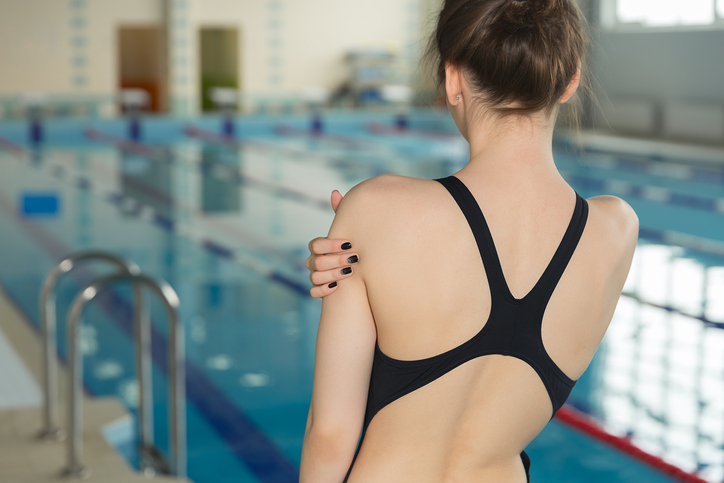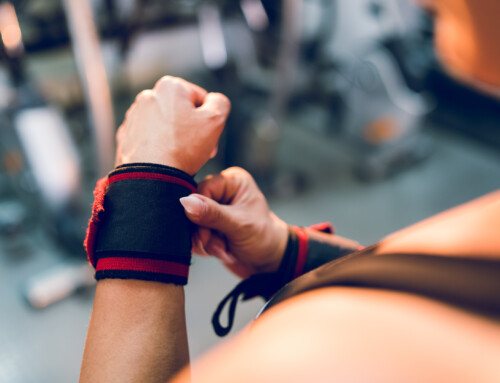By Emily Hoskinson, SPT
You’re at the height of your training for the season and the dreaded shoulder pain so common to the swim community starts. What’s going on?? You may be experiencing swimmer’s shoulder. “Swimmer’s shoulder” is a broad term used to describe a wide range of injuries that can cause pain in the front and outside of the shoulder joint in swimmers. The prevalence of swimmer’s shoulder is high, and has been reported in 40-91% of adolescent competitive swimmers at some point in their swimming career. Although painful, this injury can be resolved in a matter of months with appropriate treatment.
So, how does this happen? The shoulder is the workhorse in the sport of swimming, generating approximately 90% of the force required to propel the body through the resistance of water. The shoulder is one of the most complex joints in the human body. It is a ball-and-socket joint, which permits a wide range of motion, however this also makes the joint highly unstable and prone to injury if the surrounding musculature and tendons are not appropriately balanced. Due to the repetitive nature of swimming, some muscles are overworked and overdeveloped (namely the pectoralis major and latissimus dorsi muscles), while other important musculature including the muscles of the rotator cuff and scapular stabilizers are left weak and unable to perform effectively. This imbalance leads to the characteristic slumped posture of swimmers, which causes the humeral head (upper bone of the arm) to move up and forward in the socket, impinging on the rotator cuff musculature or the biceps tendon.
What are the signs/symptoms of Swimmer’s Shoulder to watch out for?
● Muscle weakness or fatigue
● Reduced range of motion of the affected shoulder
● Shoulder instability
● Shoulder pain
How can PT help Swimmer’s Shoulder?
A physical therapist can help alleviate your symptoms and provide appropriate care and education to prevent recurrence of the injury.
1. Your physical therapist will start by evaluating you to determine what exactly is causing your pain.
2. The initial step towards healing will likely be to discontinue the aggravating activity until the pain has subsided. Your physical therapist may recommend that you stay out of the pool altogether, or that you modify your training program temporarily. This will depend on the severity of your
3. The beginning phases of treatment may include ice application to reduce pain and inflammation, and a combination of manual techniques, such as joint mobilizations, massage, and stretching.
4. As the pain and inflammation subside, your physical therapist will prescribe a combination of strengthening exercises and stretches targeted towards stretching any muscles that are tight and strengthening the muscles that are weak. Significant emphasis will be placed on strengthening your postural muscles to alleviate stress on the shoulder joint.
References
1. Cahan E. “swimmer’s shoulder,” common in more than three-quarters of swimmers, may be caused by a sport culture characterized by “No pain, no gain. American Academy of Pediatrics. October 25, 2019. Accessed May 29, 2023. https://www.aap.org/en/news-room/news-releases/aap/2019/swimmers-shoulder-common-in-more-than-three-quarters-of-swimmers/#:~:text=Cahan%2C%20presenting%20author-,Introduction%3A%20“Swimmer%27s%20shoulder”%20is%20the%20colloquial%20phrase%20describing%20pain,swimmers%20(1%2D3).
2. Dewey N. The Top 3 Stretches to Help Treat and Prevent Swimmer’s Shoulder. Sport and Spinal Physiotherapy. September 13, 2022. Accessed May 29, 2023. https://sportandspinalphysio.com.au/the-top-3-stretches-to-help-treat-and-prevent-swimmers-shoulder/.
3. Williams RS. Swimmer’s shoulder: Signs, symptoms, stretches, and treatment. Coastal Orthopedics. August 28, 2018. Accessed May 29, 2023. https://www.coastalorthoteam.com/blog/swimmers-shoulder-signs-symptoms-stretches-and-treatment.






